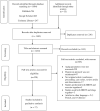Effects of Hyperoxia on Aging Biomarkers: A Systematic Review
- PMID: 35822043
- PMCID: PMC9261365
- DOI: 10.3389/fragi.2021.783144
Effects of Hyperoxia on Aging Biomarkers: A Systematic Review
Abstract
The effects of short-term hyperoxia on age-related diseases and aging biomarkers have been reported in animal and human experiments using different protocols; however, the findings of the studies remain conflicting. In this systematic review, we summarized the existing reports in the effects of short-term hyperoxia on age-related diseases, hypoxia-inducible factor 1α (HIF-1α), and other oxygen-sensitive transcription factors relevant to aging, telomere length, cellular senescence, and its side effects. This review was done as described in the Preferred Reporting Items for Systematic Reviews and Meta-Analyses (PRISMA) guideline. A systematic search was done in PubMed, Google Scholar, and Cochrane Library and from the references of selected articles to identify relevant studies until May 2021. Of the total 1,699 identified studies, 17 were included in this review. Most of the studies have shown significant effects of short-term hyperoxia on age-related diseases and aging biomarkers. The findings of the studies suggest the potential benefits of short-term hyperoxia in several clinical applications such as for patients undergoing stressful operations, restoration of cognitive function, and the treatment of severe traumatic brain injury. Short-term hyperoxia has significant effects in upregulation or downregulation of transcription factors relevant to aging such as HIF-1α, nuclear factor kappa-light-chain-enhancer of activated B-cells (NF-kB), and nuclear factor (erythroid-derived 2)-like 2 (NRF2) among others. Short-term hyperoxia also has significant effects to increase antioxidant enzymes, and increase telomere length and clearance of senescent cells. Some of the studies have also reported adverse consequences including mitochondrial DNA damage and nuclear cataract formation depending on the dose and duration of oxygen exposure. In conclusion, short-term hyperoxia could be a feasible treatment option to treat age-related disease and to slow aging because of its ability to increase antioxidant enzymes, significantly increase telomere length and clearance of senescent cells, and improve cognitive function, among others. The reported side effects of hyperoxia vary depending on the dose and duration of exposure. Therefore, it seems that additional studies for better understanding the beneficial effects of short-term hyperoxia and for minimizing side effects are necessary for optimal clinical application.
Keywords: age-related diseases; aging; aging biomarkers; effects; hyperoxia.
Copyright © 2022 Tessema, Sack, Serebrovska, König and Egorov.
Conflict of interest statement
EE is a co-owner of CellAir Construction GmbH. The remaining authors declare that the research was conducted in the absence of any commercial or financial relationships that could be construed as a potential conflict of interest.
Figures
Similar articles
-
Dietary glycation compounds - implications for human health.Crit Rev Toxicol. 2024 Sep;54(8):485-617. doi: 10.1080/10408444.2024.2362985. Epub 2024 Aug 16. Crit Rev Toxicol. 2024. PMID: 39150724
-
Increasing Oxygen Partial Pressures Induce a Distinct Transcriptional Response in Human PBMC: A Pilot Study on the "Normobaric Oxygen Paradox".Int J Mol Sci. 2021 Jan 5;22(1):458. doi: 10.3390/ijms22010458. Int J Mol Sci. 2021. PMID: 33466421 Free PMC article.
-
ROS-activated MAPK/ERK pathway regulates crosstalk between Nrf2 and Hif-1α to promote IL-17D expression protecting the intestinal epithelial barrier under hyperoxia.Int Immunopharmacol. 2023 Mar;116:109763. doi: 10.1016/j.intimp.2023.109763. Epub 2023 Feb 1. Int Immunopharmacol. 2023. PMID: 36736221
-
pPKCα mediated-HIF-1α activation related to the morphological modifications occurring in neonatal myocardial tissue in response to severe and mild hyperoxia.Eur J Histochem. 2012 Jan 31;56(1):e2. doi: 10.4081/ejh.2012.e2. Eur J Histochem. 2012. PMID: 22472890 Free PMC article.
-
Effects of Intermittent Hypoxia in Training Regimes and in Obstructive Sleep Apnea on Aging Biomarkers and Age-Related Diseases: A Systematic Review.Front Aging Neurosci. 2022 May 23;14:878278. doi: 10.3389/fnagi.2022.878278. eCollection 2022. Front Aging Neurosci. 2022. PMID: 35677200 Free PMC article.
Cited by
-
The Super Anti-Browning Effect of High-Oxygen Pretreatment Combined with Cod Peptides on Fresh-Cut Potatoes During Storage.Foods. 2025 Apr 29;14(9):1564. doi: 10.3390/foods14091564. Foods. 2025. PMID: 40361647 Free PMC article.
-
Exploiting moderate hypoxia to benefit patients with brain disease: Molecular mechanisms and translational research in progress.Neuroprotection. 2023 Sep;1(1):9-19. doi: 10.1002/nep3.15. Epub 2023 Feb 21. Neuroprotection. 2023. PMID: 37671067 Free PMC article.
-
Understanding human aging and the fundamental cell signaling link in age-related diseases: the middle-aging hypovascularity hypoxia hypothesis.Front Aging. 2023 Jun 13;4:1196648. doi: 10.3389/fragi.2023.1196648. eCollection 2023. Front Aging. 2023. PMID: 37384143 Free PMC article.
References
-
- Alex J., Laden G., Cale A. R. J., Bennett S., Flowers K., Madden L., et al. (2005). Pretreatment with Hyperbaric Oxygen and its Effect on Neuropsychometric Dysfunction and Systemic Inflammatory Response after Cardiopulmonary Bypass: A Prospective Randomized Double-Blind Trial. J. Thorac. Cardiovasc. Surg. 130 (6), 1623–1630. 10.1016/j.jtcvs.2005.08.018 - DOI - PubMed
Publication types
LinkOut - more resources
Full Text Sources


